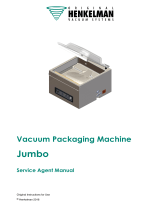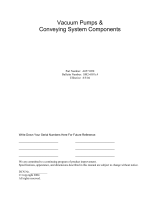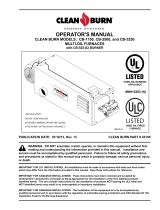Page is loading ...

SKU TPA2001R For technical questions please call 1-866-278-6653 Page
TPA2001R
PLEASE TAKE SAFETY PRE-
CAUTIONS WHEN USING
YOUR VACUUM CHAMBER.
Always wear safety glasses,
no close or prolonged view-
ing through Lexan
®
lids.
Never use the Lexan lids as
a cutting surface.
VACUUM CHAMBER
SET UP AND OPERATING INSTRUCTIONS
Model
DANGER
Diagrams with this manual may not be drawn proportionally.
Due to continuing improvements, actual product may differ from the product described herein.
Distributed exclusively by EnvironMolds, LLC
18 Bank Street / Summit NJ 07901
Visit our website www.artmolds.com
Read this material before using this product.
Failure to do so can result in serious injury.
SAVE THIS MANUAL
Copyright © 2010 by EnvironMolds, LLC. All rights reserved. No portion of this manual or any
artwork contained herein may be reproduced in any shape or form without the express con-
sent of EnvironMolds, LLC.
®

SKU TPA2001R For technical questions please call 1-866-278-6653 Page 2
SAVE THIS MANUAL
Keep this manual for the safety warnings and precautions, assembly, operating, inspec-
tion, maintenance and cleaning procedures. Write the product’s serial number in the back
of the manual near the assembly diagram (or month and year of purchase if product has
no number). Keep this manual and the receipt in a safe and dry place for future reference.
GENERAL SAFETY RULES
WARNING! Read all instructions Failure to follow all instructions listed below
may result in serious injury. The term “vacuum chamber in all of the warnings
listed below refers to your ArtMolds Vacuum Chamber.
SAVE THESE INSTRUCTIONS
1. Work area safety
a. Keep work area clean and well lit. Cluttered or dark areas invite accidents.
b. Keep children and bystanders away while operating a vacuum chamber.
Distractions can cause you to lose control.
2. Personal safety
a. Stay alert, watch what you are doing and use common sense when operating a
pneumatic tool. Do not use a vacuum chamber while you are tired or under the
influence of drugs, alcohol or medication. A moment of inattention while operat-
ing pneumatic tools may result in serious personal injury.
b. Use safety equipment. Always wear eye protection. Safety equipment
such as dust mask, work gloves, non-skid safety shoes, hard hat, or hear-
ing protection used for appropriate conditions will reduce personal inju-
ries.
c. Dress properly. Do not wear loose clothing or jewelry. Keep your hair, clothing
and gloves away from moving parts. Loose clothes, jewelry or long hair can be
caught in moving parts.
d. If devices are provided for the connection of chemical vapor extraction and col-
lection facilities, ensure these are connected and properly used. Use of these
devices can reduce vapor-related hazards.
3. Vacuum Chamber use and care
a. Do not over tighten the pneumatic fittings Use the correct tool for your applica-
tion. The correct tool will do the job better and safer at the rate for which it was
designed.
b. Disconnect the vacuum chamber from the air source before making any
adjustments, changing accessories, or storing.

SKU TPA2001R For technical questions please call 1-866-278-6653 Page 3
c. Store your vacuum chamber out of the reach of children and do not allow
persons unfamiliar with the vacuum chamber or these instructions to oper-
ate it. Vacuum chambers can be dangerous in the hands of untrained users.
d. Maintain your vacuum chamber by keeping the gaskets and lids clean and debris
free. Check for misalignment or breakage of parts and any other condition that
may affect the vacuum chamber operation. If damaged, have it repaired before
use. Many accidents are caused by poorly maintained tools.
e. Use the vacuum chamber in accordance with these instructions and in the man-
ner intended for the particular type of tool, taking into account the working condi-
tions and the work to be performed. Use of the vacuum chamber for operations
different from those intended could result in a hazardous situation.
4. Service
a. Have your vacuum chamber serviced by a qualified repair person using only iden-
tical replacement parts. This will ensure that the safety of the tool is maintained.
SPECIFIC SAFETY RULES
1. Maintain labels and nameplates on the tool. These carry important safety information. If
unreadable or missing, contact EnvironMolds, LLC, for a replacement.
2. Avoid unintentional starting. Prepare to begin work before turning on the tool
3. Do not leave the vacuum chamber unattended when a vacuum pump is operating. Un-
plug it before leaving.
4. This product is not a toy. Keep it out of reach of children.
5. People with pacemakers should consult their physician(s) before use. Electromagnetic
fields in close proximity to heart pacemaker could cause pacemaker interference or
pacemaker failure. Caution is necessary when near coil, spark plug cables, or distribu-
tor of running engine. Your pump should be off during vacuum evacuation.
6. WARNING: The brass components of this product contain lead, a chemical known to
the State of California to cause birth defects (or other reproductive harm). (California
Health & Safety code § 25249.5, et seq.)
7. For proper de-airing it is absolutely essential that the gaskets and the acrylic lids all be
perfectly clean and without cuts or cracks. Cracks in the rubber gasket, chips or cuts in
the acrylic lids or any particles or other foreign matter which might prevent a smooth
and perfect seal between the chamber, the gasket or the acrylic lid(s) can cause air
leakage and interfere with the de-airing process.
The warnings, precautions, and instructions discussed in this instruction manual cannot
cover all possible conditions and situations that may occur. It must be understood by the

SKU TPA2001R For technical questions please call 1-866-278-6653 Page 4
operator that common sense and caution are factors which cannot be built into this prod-
uct, but must be supplied by the operator.
SAVE THESE INSTRUCTIONS
SPECIFICATIONS
UNPACKING
When unpacking, check to make sure that the item is intact and undamaged. If any parts
are missing or broken, please call EnvironMolds, LLC, at the number shown on the cover
of this manual as soon as possible.
TOOLS REQUIRED FOR ASSEMBLY
Adjustable Wrench Petroleum Jelly
ASSEMBLY STEPS
1. Thread the vacuum gauge onto the brass fitting that will attach to the vacuum chamber.
Use an adjustable wrench to tighten. Do not over tighten. Plumbers tape is not re-
quired.
2. Take the assembled fitting with gauge and thread it into the side of the chamber. Use
an adjustable wrench to snug it up. Do not over tighten. Plumbers tape is not required.
Weight
20-pounds
Recommended Vacuum 24” to 29” of mercury at sea level
Recommended Vacuum Pump 3 CFM minimum
Vacuum Capacity 29.3” of Mercury /Sea Level
Capacity 4 gallons +/-
Air Inlet 1/4”-18 NPT
Interior Dimensions 12-inches high x 10-inches diameter

SKU TPA2001R For technical questions please call 1-866-278-6653 Page 5
3. Dab a bit of petroleum jelly on the hose barb fitting. Then firmly press fit the plastic tub-
ing supplied in your kit onto the hose barb.
4. Remove the protective papers from both sides of the Lexan lids. Then place one Lexan
lid on a clean flat surface.
5. Center one of the two red gaskets on this bottom Lexan lid.
6. Place the PVC cylinder/vacuum chamber evenly in the center of the bottom gasket
checking carefully that the entire perimeter of the chamber is sitting evenly on this gas-
ket.
7. Place the second red gasket centered evenly on the top rim of the chamber.
8. The second Lexan lid will be placed over that top gasket to seal your vacuum chamber.
Check to see that the gasket is sitting evenly on the rim.
9. Connect your plastic tube to your vacuum source. You are ready to use the vacuum
chamber.
OPERATING INSTRUCTIONS
Read the entire IMPORTANT SAFETY INFORMATION section at the beginning
of this manual including all text under subheadings therein before set up or
use of this product.
General Operating Instructions
NOTE: While not required for operation, it is advisable to mount
a quick release air fitting to the Air Fitting. This will make it eas-
ier to quickly attach and detach the vacuum hose from this tool.
This is available in the air tool section of home improvement and
hardware stores.
1. Mix your rubber according to the manufacturer’s directions.
Your mixing container must be large enough to accommo-
date at least four times the amount of material you are vac-
uuming, to allow for the expansion of the material.
2. Turn your vacuum pump on (not supplied). Depending on the
size of your pump your vacuum will reaches 29-inches of
mercury
Note 1
in a minute or so. When it does, the material will begin to rise (resembling
foam).
Note 2
When it rises it will remain at this heightened level while frothing for about a
minute and then collapse. When the material falls it will plateau and not rise any more.
3. Continue to maintain the vacuum for another 2-3-minutes to make certain all of the air
has been removed from your material.
4. Turn off you vacuum source and open the vacuum chamber relief valve to allow air to

SKU TPA2001R For technical questions please call 1-866-278-6653 Page 6
refill the vacuum chamber. Once the air pressure on the inside of the chamber equals
that of the outside you can easily remove the clear Lexan
®
lid.
5. Remove your material container from the chamber. Pour the material slowly starting
from the corner of the mold box, or mold, letting the material flow freely into the box or
mold cavity. This method will usually not introduce any new bubbles into the vacuumed
material. To insure that the material is totally devoid of air bubbles you can place the
entire mold/mold box into the chamber for an additional few minutes. This will assist the
material into difficult areas of the mold/mold box.
MAINTENANCE AND SERVICING
Disconnect the tool from the air outlet before performing any inspec-
tion, maintenance, or cleaning procedures.
Damaged equipment can fail, causing serious personal injury. Do not
use damaged equipment. If abnormal noise or vibration occurs, have
the problem corrected before further use.
Cleaning, maintenance, and lubrication
1. BEFORE EACH USE, inspect the general condition of the tool. Check for loose
screws, cracked or broken parts, and any other condition that may affect its safe opera-
tion.
2. AFTER USE, clean external surfaces of the tool with clean, moist cloth.
PLEASE READ THE FOLLOWING CAREFULLY
THE MANUFACTURER AND/OR DISTRIBUTOR HAS PROVIDED THE PARTS LIST AND ASSEMBLY
DIAGRAM IN THIS MANUAL AS A REFERENCE TOOL ONLY. NEITHER THE MANUFACTURER OR
DISTRIBUTOR MAKES ANY REPRESENTATION OR WARRANTY OF ANY KIND TO THE BUYER
THAT HE OR SHE IS QUALIFIED TO MAKE ANY REPAIRS TO THE PRODUCT, OR THAT HE OR
SHE IS QUALIFIED TO REPLACE ANY PARTS OF THE PRODUCT. IN FACT, THE MANUFAC-
TURER AND/OR DISTRIBUTOR EXPRESSLY STATES THAT ALL REPAIRS AND PARTS REPLACE-
MENTS SHOULD BE UNDERTAKEN BY CERTIFIED AND LICENSED TECHNICIANS, AND NOT BY
THE BUYER. THE BUYER ASSUMES ALL RISK AND LIABILITY ARISING OUT OF HIS OR HER RE-
PAIRS TO THE ORIGINAL PRODUCT OR REPLACEMENT PARTS THERETO, OR ARISING OUT OF
HIS OR HER INSTALLATION OF REPLACEMENT PARTS THERETO.
ote 1: Your vacuum pump needs to be capable of pulling 29-inches of mercury at sea level to do an adequate de-airing in the shortest time
period. However at higher altitudes you will be unable to achieve 29-inches. For example in the mile high city of Denver 24-inches of mercury
is deemed acceptable. However, you will have to run your vacuum several minutes longer than at sea level.
ote 2. Thicker and thixotropic rubbers may not rise due to mass. In that case, rocking the vacuum chamber back and forth will enable the de-
airing material to move up the container wall and ultimately collapse.

SKU TPA2001R For technical questions please call 1-866-278-6653 Page 7
PARTS LIST & ASSEMBLY DIAGRAM
TROUBLE SHOOTING
Part Description Qty
1
Chamber body 1
2
Rubber gaskets 2
3
Lexan lids 2
4
Vacuum gauge 1
6
Hose barb 1
7
Cross T 1
8
Nipple 1
9
Vacuum tube 1
10
Owner’s manual 1
5
Exhaust valve 1
PROBLEM SOLUTION
No vacuum 1. Check electric power connection. Of your vac-
uum pump
2. Check vacuum hose for secure connections
and/or cracks or defects.
3. Ensure that the air valve on the vacuum cham-
ber is completely closed.
4. Ensure that a good, clean seal is made be-
tween the housing, the rubber gasket and the
acrylic cover over vacuum chamber.
5. Ensure that the valve fitting assemble is tight
and securely tighten to the chamber body
6. You can check for leak location using soapy
water
Vacuum level is low 1. Ensure that the air valve on the vacuum cham-
ber is completely closed.
2. Ensure that a good, clean seal is made be-
tween the housing, the rubber gasket and the
acrylic cover over vacuum chamber.
3. Check for leaks
Water in oil As the vacuum pump pulls moist air from the atmos-
phere some of the water vapor is deposited in the oil
chamber of your vacuum pump. After every 6-8
hours of use, drain the water through drain valve.
The oil and water must have had adequate time to
separate prior to draining off the water, and most
operators find it advantageous to drain the water
immediately prior to a new run rather than to wait for
the water and oil to separate at the end of a run.
Oil overflows from vent does stop vacuum pump. This should never happen if the pump is properly
purged of water as described in “Water in oil” above.
5
3
2
4
6
7
3
2
1
8
9

SKU TPA2001R For technical questions please call 1-866-278-6653 Page 8
IMPORTANT CHECKS
Proper Seal. For proper de-airing it is absolutely essential that the gaskets and the acrylic
lids all be perfectly clean and without cuts or cracks. Cracks in the rubber gasket, chips or
cuts in the acrylic lids or any particles or other foreign matter which might prevent a
smooth and perfect seal between the chamber, the gasket or the acrylic lid(s) can cause
air leakage and interfere with the de-airing process.
Vacuum Air Valve. Prior to operation, close the exhaust valve on the vacuum chamber.
The vacuum pump is not supplied with your vacuum chamber. But we remind you that for
continued trouble-free operation your pump should be regularly checked as follows:
Vacuum Pump Oil Level. Vacuum pump oil should be filled to the center of
the sight glass to ensure proper de-airing. If, during or after use, it becomes
apparent that the level has risen significantly above the center of the sight
glass, water has been introduced into the oil. Refer to your Vacuum Pump
Maintenance Instructions to remedy.
Vacuum Pump Maintenance. Humid air passes through the pump during the
de-airing process. If so equipped, the pump air filter separates most of the
moisture from the air with the water settling into the air filter’s reservoir. As it
accumulates the water needs to be drained through the valve at the base of
the reservoir. Every pump is differently configured so check your manual. Also,
residual moisture not captured within the air filter reservoir will migrate into the
oil within the vacuum pump. That water needs to be drained through the valve
usually located at the base of the vacuum pump. See the pump manual.
LIMITED 90 DAY WARRANTY
EnvironMolds, LLC makes every effort to assure that its products meet high quality and durability standards,
and warrants to the original purchaser that this product is free from defects in materials and workmanship for the
period of 90 days from the date of purchase. This warranty does not apply to damage due directly or indirectly, to
misuse, abuse, negligence or accidents, repairs or alterations outside our facilities, criminal activity, improper instal-
lation, normal wear and tear, or to lack of maintenance. We shall in no event be liable for death, injuries to persons
or property, or for incidental, contingent, special or consequential damages arising from the use of our product.
Some states do not allow the exclusion or limitation of incidental or consequential damages, so the above limitation
of exclusion may not apply to you.
This warranty is expressly in lieu of all other warranties, express or implied, including the warranties of mer-
chantability and fitness.
To take advantage of this warranty, the product or part must be returned to us with transportation charges pre-
paid. Proof of purchase date and an explanation of the complaint must accompany the merchandise. If our inspec-
tion verifies the defect, we will either repair or replace the product at our election or we may elect to refund the pur-
chase price if we cannot readily and quickly provide you with a replacement. We will return repaired products at our
expense, but if we determine there is no defect, or that the defect resulted from causes not within the scope of our
warranty, then you must bear the cost of returning the product.
/



